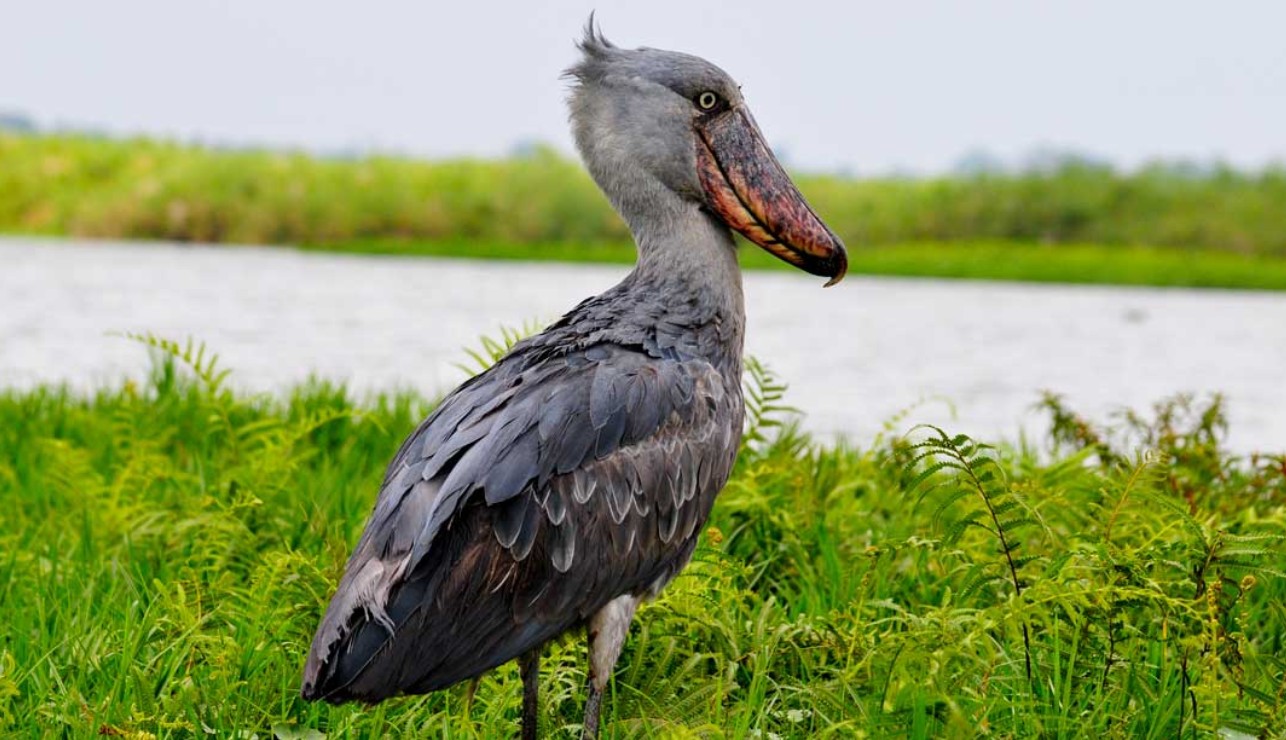
Explore Uganda’s Premier Shoebill Habitat with Muganzi Safaris at Mabamba Swamp birding Uganda
Just 12 kilometers west of Entebbe, on the northern shores of Lake Victoria, lies the remarkable Mabamba Swamp birding Uganda — a vast wetland paradise covering more than 2,400 hectares. The swamp is made up of thick papyrus marshes, water lilies, and wetland grasses that provide refuge to over 300 bird species.
Mabamba is more than a birdwatching spot — it’s a Ramsar-listed Wetland of International Importance (since 2006) and one of BirdLife International’s Important Bird Areas (IBA). It plays a key ecological role by supporting globally threatened species, including Uganda’s most iconic bird — the Shoebill Stork.
A Community Conservation Success Story
Mabamba’s story is one of people and nature living in harmony. Through community sensitization and conservation programs, local residents now protect the wetland instead of encroaching on it.
Many fishermen have become expert bird guides, using their deep knowledge of the swamp to help visitors spot rare birds. Tourism has created new opportunities — and today, the people of Mabamba understand the value of preserving their environment.
When you visit, your park and guide fees directly support local families and wetland conservation — ensuring this natural wonder remains unspoiled for generations.
Getting to Mabamba Swamp
There are two main routes to Mabamba — by road or boat.
From Entebbe:
Follow the old Entebbe–Kampala road and turn off at Kisubi. Continue through Nakawuka and Kasanje to reach Mabamba.
From Kampala:
You can take a taxi to Kasanje trading center, then hop on a Boda Boda (motorcycle taxi) for the final 13.5 km to the swamp. Alternatively, drive along the Masaka Road for about 30 km, then turn off toward Buyege, located roughly 22 km from Mabamba.
By boat:
A speedboat ride across Lake Victoria offers a scenic and faster route. It takes about 45–50 minutes from Entebbe to Mabamba. The boat trip provides sweeping lake views and avoids city traffic. On arrival, you’ll transfer to smaller traditional canoes, which are perfect for gliding quietly through the papyrus channels.
What to Expect During Your Visit
At the landing site, expect to find friendly local guides and fishermen ready to take you birding. Each group is assigned a licensed guide and boatman. Only three visitors can fit in a canoe, ensuring a peaceful and personalized experience.
-
Community entry fee: about $7
-
Boat and guide fee: around $35
Always carry or request a life jacket, as some boats may not have them onboard. Your payment supports community livelihoods and conservation — protecting the swamp’s biodiversity while benefiting local residents.
The Star of Mabamba Swamp birding Uganda — The Shoebill Stork
The Shoebill Stork is the undisputed star of Mabamba Swamp. Its enormous shoe-shaped bill, prehistoric look, and calm behavior make it a must-see for birdwatchers and photographers alike.
Mabamba is Uganda’s most reliable location to see the Shoebill — possibly the best in all of Africa. Around a dozen individuals live here, hunting mainly for lungfish, locally known as mamba.
Interestingly, local fishermen once believed seeing a Shoebill meant bad fishing luck, leading to conflicts with the bird. Today, thanks to tourism, this belief has changed. The same fishermen now protect Shoebills and eagerly help visitors spot them.
Best time to see the Shoebill:
Early morning — between 7:00 and 9:00 a.m. — when the bird hunts silently, standing still for long periods as it waits for lungfish to surface.
Other Birds of Mabamba Swamp birding Uganda
Besides the Shoebill, Mabamba is a haven for water birds, including:
-
African Fish Eagle
-
Purple Heron
-
Papyrus Gonolek
-
Malachite Kingfisher
-
African Jacana
-
Blue Swallow
-
Goliath Heron
-
Grey-crowned Crane
-
Pied Kingfisher
-
Yellow-billed Duck
-
Village Weaver
-
Swamp Flycatcher
Over 300 species have been recorded, making Mabamba a birding paradise for both beginners and professionals.
Beyond Birding — More to See and Do
Canoeing Adventure
Enjoy a peaceful canoe ride through the swamp’s quiet waterways, guided by a local fisherman who knows every corner of the wetland.
Fishing Experiences
Fishing is the main livelihood here, with catches like tilapia, lungfish, and Nile perch. Visitors can observe traditional fishing methods or join locals to try catching a fish or two.
Spotting the Sitatunga
If you’re lucky, you might see the shy Sitatunga antelope — a rare swamp-dwelling mammal found in very few places in Uganda.
Cultural Visits and Crafts
Visit nearby villages to meet local families, learn about their way of life, and shop for handmade crafts such as baskets, mats, and papyrus products.
Where to Stay — Nkima Forest Lodge
The Nkima Forest Lodge is the closest and most comfortable accommodation near Mabamba. Set in the serene Nkima Forest, the lodge overlooks Lake Victoria and the Mabamba wetlands.
It features cozy cottages, a restaurant, and observation decks where guests can spot monkeys, squirrels, and forest birds right from the lodge. It’s the perfect base for birdwatchers starting or ending their Uganda safari.
Plan Your Mabamba Birding Trip with Muganzi Safaris
Whether you’re a seasoned birder or a curious traveler, Mabamba Swamp promises unforgettable encounters with Uganda’s rarest birds and breathtaking natural beauty.
At Muganzi Safaris, we organize guided birdwatching tours from Entebbe or Kampala to Mabamba Swamp — with experienced guides, comfortable transport, and personalized service.
👉 Book your Mabamba Birding Tour today!



